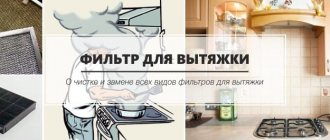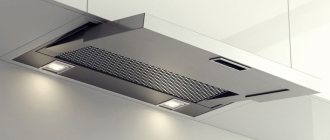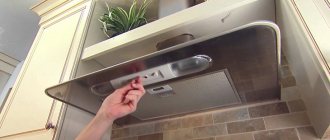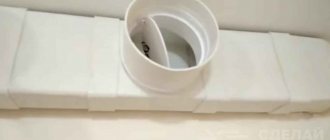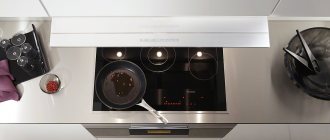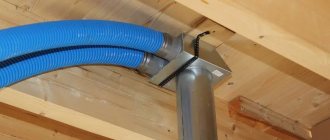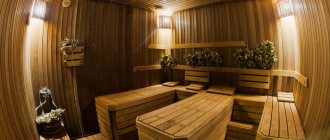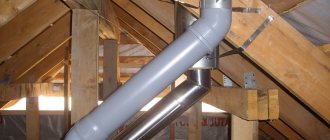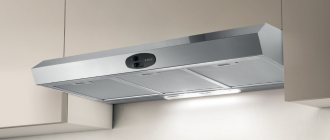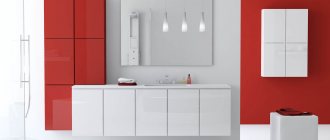For many housewives, a range hood is a must-have appliance in the kitchen. But it is not always possible to connect it to an air duct or simply take it outside. For such cases, there is an alternative - kitchen hoods without ventilation: they operate in air recirculation mode, which allows you to achieve freshness in a short time.
Question No. 1. Recirculation mode - what is it?
A conventional hood is a fan that sucks in air and sends it under pressure into the air duct or directly to the street. The recirculation unit is not connected to the air duct. We can say that it does not draw air under pressure, but is more like a fan with a filter that purifies the air. In this case, the air is not removed from the kitchen, but simply cleaned and released back into the air.
Recirculation is the name given to this process of ventilation, cleaning and re-introducing air into the kitchen. It turns out that the same air is “used” several times. This increases the humidity in the room, which can be critical for the kitchen.
A. Recirculation.
B. With a tap.
Are there any negative properties of the hood?
Despite the benefits of a kitchen appliance, there is a point of view that it can cause harm. Disputes on this matter do not subside. Below are several popular misconceptions and their refutation.
| Myth | In fact |
| Grease traps with settled fat particles are a favorable environment for the growth of bacteria. | Timely cleaning and replacement of filters makes the device completely safe. In addition, grease deposited on furniture and tiles poses the same threat. |
| The noise of the hood gets on your nerves and drowns out other sounds. | There are silent hoods on the market (for example, PYRAMIDA BR 60/A WHITE). Besides, the kitchen is already full of sounds. Against the background of the noise of tap water, boiling food and the operation of the same refrigerator, the noise of the hood is almost unnoticeable. |
| A ventilation system is sufficient to clean the air. | Indeed, in an ultra-compact kitchen, an open window is often enough. But how much a winter draft justifies the cleanliness and freshness of the air is up to each user to decide. |
Read more on the topic: WHY IS THE HOOD SO NOISE? 3 MOST COMMON SITUATIONS
Question No. 2. What are they?
In general, recirculating hoods (without vent, carbon, filter) repeat the design of their colleagues with vent. There may also be additional functions such as backlighting or speed control. But the main difference between coal specimens without connection to ventilation is their placement:
- Hanging - a standard option that is mounted on the wall.
- Built-in - again attached to the wall, but the body hides in a closet.
- Island (stand-alone) - attached to the ceiling, suitable for a stove installed in an island.
The first two options are considered the most popular, so their model range is much wider than the others.
According to the type of housing they are divided into:
- horizontal fireplaces are the most familiar to the eye, where the working area of the hood is parallel to the working area of the stove;
- vertical - in such cases, the working areas of the stove and hood are perpendicular to each other. Unusual model with low performance - suitable only for large kitchens;
- inclined flat - the working area is at an angle to the stove. Looks impressive, works efficiently and silently, saves space;
- cassette (telescopic) - the working area of such models extends. After finishing work, it can be pushed in. Compactness is the main advantage.
Choosing the type of cabinet is not only based on personal preferences, but also based on the style of the kitchen. For example, no matter how popular inclined models are now, they will not fit into a classic interior.
There is also a classification based on the material from which the body is made.
| Metal (stainless steel, aluminum) | Suitable for use in high-tech, loft, and minimalist kitchens, as it will emphasize the modernity of the style. |
| Enamel | The most budget models, but the advantages are ease of maintenance. |
| Strained glass | A very beautiful piece of equipment that requires careful care and attention - it may not survive an accidental hit with a frying pan. |
Features of corner cleaning equipment
To save space, the stove and range hood can be installed in the corner of the room. The device can be a suspended dome or “T”-type. The hood operates either in a standard way, connecting to the central ventilation system, or in recirculation mode, filtering the air.
By using a corner hood, your kitchen can take on a more modern look and integrate perfectly into the interior. The functional model gives the space additional expressiveness without overloading it. Modern modifications allow you to install the device at an angle, which makes it possible to organize lighting of the working surface adjacent to the stove.
Advice! The use of corner technology makes it possible to especially successfully hide a wide ventilation duct and all necessary communications, thereby giving the interior a more harmonious and bright look.
Question No. 4. What types of filters are there and how do they work?
In the standard set, the recirculation hood has two filters.
| Grease trap | It is through this filter that the air passes first. A metal (most often aluminum) shield with a fine mesh designed to trap large particles. Requires periodic cleaning, for example with regular dishwashing detergent. If heavily soiled, you can soak it. Metal is the most popular material for a grease filter, but in cheaper models you can also find other options, such as acrylic. |
| Coal (replaceable) | Charcoal can absorb odors, which is why it is used as a second filter. At the same stage, smaller particles are removed from the air. This filter cannot be cleaned, so it must be replaced. |
There are other filters, such as water filters. But they are used only in professional equipment in public eating places.
Types of hoods
Kitchens can have two types of ventilation: natural and forced. Each option is characterized by both positive and negative properties. We will not consider the external design; today there is a huge range of models. It is necessary to dwell only on the fundamental differences between the devices. Forced ventilation also has two types.
- Exhaust air without cleaning is supplied to vertical ventilation ducts. A flow hood removes air, the pressure in the kitchen decreases, fresh air enters through cracks in windows and doors or from special vents.
- The hood has special filters; air is forced through them and cleaned of grease, smoke, harmful chemical compounds and unpleasant odors. Clean air is again supplied to the room.
Flow and recirculation hoods
It is the second option that needs to be discussed in detail.
Find out how to install a kitchen hood with ventilation outlet yourself in a special article on our portal.
Question No. 5. How often do they need to be changed?
The anti-grease filter is not changed, but only cleaned as needed. Since it is in a visible place, it is easy to determine when cleaning is required - by the amount of dirt, dust and grease drops. It also depends on how often the hood is used.
Typically, the grease trap is wiped with a sponge and detergent once every 2-3 months.
To clean the filter from grease, you can also use folk remedies, for example, wash it with soda. To do this, apply soda to a damp sponge, wait until it softens a little, and then simply wash it.
There is a more modern option - wash it in the dishwasher.
Afterwards, the filter must be dried and inserted back. How to install it correctly in the hood can be found in the instructions. Usually this item does not raise questions or problems.
With a carbon filter the situation is more complicated. Even manufacturers give different wording in the instructions, for example:
- after a certain period (6–12 months);
- when the operation of the hood deteriorates (it begins to suck air worse, makes more noise, aromas do not disappear);
- according to the sensor readings - they are installed in the most expensive models and allow you to change the carbon filter just in time.
There are several factors that determine how long a carbon filter will last:
- on its quality - in more expensive models, the filters are of better quality and will last longer, while cheap ones can become dirty too quickly;
- how often, and what kind of food is prepared - if the diet consists only of fatty foods, then the filter will become dirty much faster. If only steamed cutlets are cooked 2-3 times a week, then replacement will not be needed soon.
It is difficult to name the average service life of a carbon filter. With frequent cooking of fatty foods, it can live for only a month. If cooking is not frequent and not aromatic, then this period can last up to a year.
How much does one such filter cost?
Its average cost is from 250 to 700 rubles. It turns out that it is more profitable to buy one good filter than to frequently change cheap ones.
Types of hoods without venting
If we compare two types of hoods - with and without ventilation outlets - then the first category has more advantages. The main advantage is higher performance, due to which air exchange occurs much faster.
Sometimes a number of technical issues prevent the installation of an exhaust device with a ventilation duct, and you have to buy a kitchen hood without an outlet and connection to the ventilation, that is, a recirculation one.
Based on the installation method, there are two types of hoods: separately installed and built-in. Built-in ones are good because they take up minimal space, and the cabinet in which the working unit is hidden is used additionally for its intended purpose - for storing kitchen utensils
Modern air purification devices differ in their materials, design, and technical capabilities.
Image gallery
Photo from
What are filter devices made of?
Various colors of hoods
Hoods for kitchen islands
Technical equipment of exhaust devices
The cost of devices directly depends on the technical “filling”, the quality of carbon and grease filter elements, design and level of the manufacturer. But you should choose carefully: sometimes models of popular brands are no different from little-known manufacturers, but cost 2-3 times more.
Question No. 6. Is it possible to make a carbon filter with your own hands?
Not everyone wants to spend money on expensive consumables, so the question arises what can replace them. Activated carbon from the nearest pharmacy costs a few rubles!
This option is only suitable for those filters that have real fractional carbon inside, and not a sponge or paper cloth soaked in it. In this case, the filter must be disassembled, the dirty coal must be pulled out and thrown away, and a new one must be filled in.
New coal, if it is in tablets, and not a special fractional one, it is advisable to crush it a little - the tablet can be divided into 3-4 parts.
You can do without new carbon: the second method is quite labor-intensive and is necessary only in cases where this carbon filter is no longer produced or it is impossible to find an analogue of the same diameter.
The filter must be disassembled, all the coal taken out and heated with a burner until red-hot, and allowed to cool. After this, assemble the structure back and install it in place. You can watch the video in more detail about the procedure itself, how to restore the filter and what it looks like before and after.
How to restore a kitchen hood's carbon filter.
Read more about extractor hood filters
Devices that operate without venting into the ventilation shaft are called coal devices due to the presence of carbon filters, which purify the air from specific kitchen odors. Most often these are plastic cassettes of various shapes and filled with activated carbon.
Sometimes pieces of synthetic material, also impregnated with activated carbon, are additionally used.
Round charcoal cartridges filled with granules or powder are usually sold and used in pairs. The plastic from which they are made does not change properties when heated and is safe for health.
In addition to the carbon filter, there is an anti-grease filter. For built-in models, it is located on the bottom panel and is a metal grille or mesh.
Of course, the mesh cannot catch odors, but it does an excellent job of removing particles of dissolved fat that rise with the steam. In this regard, it is recommended to wash the anti-grease filter approximately once every 30-40 days with non-abrasive agents.
Unlike the carbon filter, which is placed in the hood body along with the motor and fans, the metal grille is visible and is part of the design of the models.
When purchasing replacement products, please note that original and non-original (universal) filters are available for sale. The second group is suitable for many models and is lower in cost than parts produced by the manufacturer.
Carbon filters, as a rule, last for 3-4 months of active use, but the exact data is indicated in the instructions.
Question No. 7. What are the features of a recirculating hood?
It is important to know all the pros and cons that you can expect from a kitchen hood without corrugation. This information will allow you not to be disappointed in your choice in the future.
| Advantages | Flaws |
| You can hang equipment even where connection to an air duct or output to the street is impossible | Expensive filters need to be replaced. Sometimes these filters are also difficult to find |
| Cost savings, since hoods without outlets are cheaper than their “outlet” counterparts. In addition, there is no need to spend money on additional details such as air ducts, fastenings and decor to hide | Small selection of hood models without outlet |
| More compact size and neat appearance | Recirculating hoods are considered noisier, since their task is to “push” air through the carbon filter, and this requires power |
| If there is still a ventilation shaft, then it will not be occupied by the exhaust duct - air exchange will not be disrupted | Efficiency is not maximum - even the most expensive filters are not able to remove odor completely |
| Easy to install and install - no need to install an air duct | |
| Additional air flow is not needed even during long-term operation of the equipment | |
| No special care required, only filter replacement required |
Advantages and disadvantages of such a hood
The advantages of such structures include:
- compact, elegant appearance. Good compatibility with kitchen sets or appliances;
- ease of installation, no air ducts;
- there is no need to connect to the general house ventilation;
- there is no dependence on the condition of the ventilation ducts or on external (weather) conditions;
- the air is purified, which ensures normal quality of the atmosphere throughout the apartment (at least in neighboring rooms);
- during operation of autonomous units there is much less noise than from conventional hoods;
- The device can be placed anywhere in the kitchen. There is no connection to ventilation tracing;
- the umbrella is equipped with additional devices (timers, lights, thermometers, etc.) to make work in the kitchen easier;
- The dimensions of such devices are more compact. Allowing them to be used with standard kitchen sets.
The disadvantages of autonomous hoods include:
- there is no air exchange, so some of the unwanted components remain in the kitchen atmosphere;
- no pressure difference is created in the kitchen area, so there is the possibility of odors, humidity and heat spreading throughout the apartment (house);
- It is necessary to periodically change the filters, otherwise there will be no point in the operation of these devices. At the same time, the cost of high-quality filters is quite high;
- connection to the power supply is required.
User reviews of such devices have a wide variety of opinions. Some note the low efficiency or high cost of replacement filters, others find the design attractive or the lack of need to connect to ventilation is suitable, and they are pleased with the ease of installation. This diversity of opinions forces us to approach the selection of a suitable model without taking into account user reviews, but only on the basis of an analysis of technical characteristics.
Question No. 8. For what cases is this ideal?
The main reason to install a recirculating hood is the inability to vent polluted air into the shaft or outside. There are several reasons for this:
- the mine is too far from the intended installation site of the hood, and there is no desire to build labyrinthine paths from corrugated paper;
- there is a shaft, but there are problems with the ventilation, for example, all the air with aromas gets to the neighbors;
- there is no shaft at all or there is no hole in the kitchen;
- the presence of reverse draft in ventilation (for example, when gas boilers or water heaters are installed) - the use of a standard hood here increases the risk of carbon monoxide poisoning;
- The air duct does not fit into the design.
The conclusion suggests itself is the following: a hood without an outlet should be chosen only if there is no possibility of making a hood with an outlet, since the latter is much more efficient and has a simpler operating mechanism.
Exterior design
There are almost no limits here and there cannot be any. We can roughly identify the following directions in device design:
- high tech;
- Provence;
- classic;
- other types and types.
Many models are designed to fit into multiple style combinations, increasing their versatility. This is also convenient for buyers - it’s easier for them to find a hood to suit their kitchens, no matter what style they are decorated in.
Corner hood in the kitchen of a country house
Question No. 9. How to install correctly?
As mentioned above, installation of a hood without outlet is very simple. There are just a couple of features to keep in mind:
- the height at which the hood will hang depends on the type of stove - if gas, then 75–85 cm, if electric, 65–75 cm;
- The hood itself is hung with bolts to the wall or ceiling, depending on the model.
That's all - no additional actions such as laying an air duct and covering it with decorative cabinets or installing grilles are required. To make sure you don’t miss anything, you can refer to the following step-by-step instructions:
- Check the strength of the base on which the equipment will be attached.
- Read the instructions and check the mounting kit that is required.
- Measure the distance from the hob to the bottom of the hood (the norm is indicated above).
- Check whether there is room for air to escape into the free space.
- Check the length of the wire and the presence of grounded outlets.
- Mark the locations of future fastenings.
- Install the fasteners using a drill or screwdriver.
- Hang the hood;
- Enable and check functionality.
This principle of operation is suitable for most models, but it is best to check the manufacturer's instructions for any installation or work specifications. The advantage is that the hood is easy not only to hang, but also to remove as soon as the need arises.
Types of recirculation exhaust systems for the kitchen
We are used to dividing existing units for combating unpleasant odors after cooking into coal and flow-through ones. Today we will look at how, in turn, the first options are divided into types. Additionally, hoods without air ducts vary in terms of technical specifications, design, as well as the number of cleaning levels and installed filters. In addition, these devices are built-in and wall-mounted.
- The good thing about the built-in model of a coal hood is that the entire block, in which the working mechanism is hidden, is placed directly in the kitchen unit, thus not aggravating the kitchen space with completely unnecessary details.
- Attachment devices do not require installation in cabinets, so they can only be attached to the wall and represent a unit of considerable size. However, there are also compact hoods, which are often purchased for small kitchens.
Don’t buy into the luxury of a charcoal hood model; study the entire range thoroughly, because little-known brands can be just as high-quality.
GOOD TO KNOW!
We advise you to buy models with low noise levels, as they can work directly while the hostess is cooking and in the kitchen, creating a favorable atmosphere
Mechanical control of hoods is divided into push-button and slider. You will have to decide on your convenience yourself.
Question No. 10. Is there two in one?
In fact, hoods are divided not only into two types (with and without vent). There is also a third - the most universal combined option - combining both of these modes. This technique can suck in air and discharge it into the ventilation or street, and in another mode, simply drive the air through a filter.
Such models appeared quite recently, but they are still not popular for two reasons:
- the price of such equipment is noticeably higher than analogues with one function;
- The recirculation mode is clearly inferior in efficiency to a conventional hood, so there is a chance you may even forget how to convert these modes - it will not be used.
It turns out that there is no point in a 2 in 1 hood, and there is no need to spend money on it.
Typical ventilation schemes in the kitchen
There are two main schemes for kitchen ventilation: natural and forced. In the first case, ventilation is carried out using holes in the walls and open vents, on the one hand, and general house ventilation ducts on the other.
In the second case, air change is carried out mechanically, using the installation of volatile devices. The third, combined option is considered the most successful, in which a natural supply circuit is simultaneously used, according to which air spontaneously enters the room, and forced exhaust through kitchen hoods.
According to the method of air purification, all hoods can be divided into 2 types - exhaust (intake) and recirculation. The latter are not connected to ventilation ducts through pipes and ducts and operate autonomously
There is a third type - combined devices, which are equipped with double filters and an air duct, and can work either connected to the ventilation shaft or independently.
Natural ventilation has the only advantage: to ensure a comfortable microclimate in the kitchen (as in other rooms) no additional material investments are required.
But it has low efficiency. When cooking on an electric or gas stove, heavy odors quickly spread due to slow air exchange.
Devices for providing forced ventilation are much more productive, but the equipment required to implement the mechanical circuit is dependent on the supply of electricity.
Exhaust hoods and recirculation units do an excellent job of cleaning dirty air and removing unpleasant odors, but they do not cover the area under the ceiling, where fumes and grease particles also enter
Taking into account these features, a combined scheme is used, combining the operation of exhaust devices and a natural ventilation system.
You can get acquainted with typical diagrams and options for ventilation in the kitchen in an article that we recommend reading.
Question No. 11. How to choose the best model?
There are several factors that need to be taken into account. Whether the owner will be disappointed in her purchase after a while or, conversely, will be happy, depends on how the hood looks externally and what characteristics it has. To achieve the second option, you need to try hard and pay attention to the following points.
Performance
Productivity is a measure that shows how effectively a certain job is done. In the case of a hood, this is to clean the air from third-party aromas. There is a special formula that will help determine the optimal performance for a specific kitchen.
You need to multiply the following values:
- ceiling height (for example, 2.5 m);
- length of the room (for example, 3.5 m);
- width of the room (for example, 3 m);
- coefficient 15.6.
This will result in optimal performance for a particular kitchen - this is the value you should focus on when choosing a hood.
You can get by with a simpler table.
| 200–300 m3/h | For a small kitchen where simple dishes are sometimes prepared |
| 300–400 m3/h | For an average kitchen or a family of 3-4 people who eat a varied diet |
| 500–600 m3/h | For large families who love to eat delicious food and experiment with cuisine |
Dimensions
The dimensions of the hood should depend on the stove over which it is located. The rule is this: the hood has the same dimensions (length and width) or larger. In no case should it be less, since the effect of the technology in this case will tend to zero.
It is advisable to select a slightly larger slab: either in width or in length. The best option is when the hood is 10 centimeters wider than the slab - then 5 cm remain on each side. The advantage in length is also acceptable, but it is not so comfortable when cooking - there is a risk of hitting the dome with your head.
Standard hood width: 50, 60, 70 cm.
Noise level
It’s not very good if the neighbors think that instead of a new hood you bought an airplane that flies around the apartment several times a week. The noise can also disturb the owners of the equipment themselves, especially if there are small children or not the bravest animals.
To make cooking comfortable even with the hood on, you should look for equipment with a noise level of 50–55 dB. The quietest models operate at a level of 35–42 dB.
It is worth noting that cost is not an indicator of noiselessness, and perhaps even the opposite: expensive models are the most powerful, which means they can produce a lot of noise. It is better to focus on the number of decibels.
Additional functions
Additional functions of the hood can also make the housewife’s life easier:
- timer is a convenient function for those cases when the dish itself is also prepared using a timer, for example, in an oven or multicooker. The timer will allow you to set up the operation of equipment according to a schedule;
- the ability to change speeds is a useful function that will help regulate the hood power depending on the degree of air pollution;
- The electronic display is a small detail that will make working with the hood much more convenient. You can immediately see the mode in which the equipment operates, and also, if something happens, an error code will appear, which will help you save a lot of money on repairs;
- indicators - we are talking about indicating the degree of contamination of the carbon filter. Such a system will allow it to be changed in a timely manner, which means that the efficiency of the hood will not decrease;
- built-in sensors - the most advanced models have sensors that themselves determine the degree of air pollution around them. If necessary, they turn on or off independently;
- remote control - controlling the hood using a remote control is especially convenient in the kitchen-living room or in the studio.
As an additional function, you can also select a flashlight, but at the moment it is found in almost all hoods - even the most inexpensive ones.
Brand
It is also important to pay attention to the manufacturer’s brand, since this is to some extent a guarantee of quality. It is known that some budget brands skimp on technology and materials, so their customers do not leave service centers. But there are also time-tested brands that do not skimp on quality.
| Ariston | The best-selling brand of household appliances in Russia. Assembled in Italy, which is reflected in the ideal style and even beauty, without sacrificing quality. |
| Bosch | The range of hoods is very wide and varies in design and cost. Most often assembled in Germany, so it is initially considered more reliable. |
| Gorenje | Gorenje has long specialized in filter hoods, so it can boast of impeccable quality. The perfect balance of functionality and resource consumption. Made in Slovenia. |
| Electrolux | This Swedish manufacturer is worth contacting if you want the latest technologies, innovations and unusual features. Simple and comfortable control is another hallmark of Electrolux equipment. |
| Zigmund-Stain | If an unusual and bright design is important, then you should pay attention to this German brand. The quality is comparable to the mentioned competitors. |
Hoods from famous brands
Due to their engineering features, recirculating types of hoods do not belong to the category of very complex products; therefore, many companies are engaged in their production. But not all of them treat consumers responsibly and do not pay due attention to the quality of materials and technological processes.
Which companies meet current consumer demands?
Table. Popular models of hoods
| Name of recirculation hood | Description and brief operating characteristics |
| Low noise hood, has effective sound insulation of the mechanical compartment and the most modern sealed bearings. Touch electronic control, fan power 800 m3/hour, which is quite enough even for large kitchens. There are three main speeds of operation; in addition, you can turn on perimeter or intensive suction. LED backlight increases the attractiveness of the device, the noise level is no more than 60 dB. The disadvantages include the lack of a carbon filter. |
| A very original appearance can decorate not only kitchens; such hoods can be installed in work rooms if its owner and guests have not given up the bad habit of smoking. Designers recommend using units in modern studio kitchens. Electronically controlled hood, width 100 cm, capacity 550 cubic meters. meters. The electric motor with an extended operating hours has three speeds and an intensive mode. This mode is used to quickly clean the air in case of critical smoke pollution. An advantageous advantage is the presence of a filter contamination indicator, which simplifies its timely cleaning or replacement and increases the operating time of the unit. Disadvantage - the noise level is 75 dB, which is quite high for residential premises. |
| The hood resembles an ordinary pendant lighting fixture, and therefore can be installed in any room. It has two filters, which improves the quality of air purification. Touch control system, four operating speeds, there is a remote control. The design is improved due to halogen lighting; the fan power is 550 m3/h. Disadvantages - the carbon filter clogs relatively often; untimely replacement has a negative impact on the duration of operation, the quality of air purification and operating noise. |
| The very compact hood barely attracts attention and successfully imitates a modern lamp with LED bulbs. An air pollution control indicator tells owners when to turn on the device. The control is electronic, there is a remote control. With a capacity of up to 830 cubic meters of air per hour, the hood occupies a leading position among household units in terms of this parameter. Using a timer, automatic on/off settings can be made; there are three operating speeds and an intensive air purification mode. A noise level of 66 dB fits within the tolerance range for this type of household appliance. Disadvantages: high cost and lack of a carbon filter. |
| Built into suspended and suspended ceilings, the enclosed space further reduces operating noise. The engine power is only 220 W, which makes it possible to reduce energy losses and reduce financial costs. Height 19 cm, productivity 830 m3/h, there are three operating speeds. If you need to quickly clean the air, the intensive mode is activated. Automation allows users to configure the optimal interval mode of on/off. There is an option for air suction around the perimeter of the device, the noise level is no more than 50 dB - one of the lowest values among all types of household hoods. The disadvantage is the high cost and the lack of a carbon filter. |
| An original hood built under the countertop. The fan capacity is 960 m3/h, has four operating speeds and touch control type. Duplicated by a portable remote control. The maximum noise level does not exceed 66 dB; two filters are installed to capture grease and unpleasant odors. Disadvantage: the very high cost significantly reduces the number of potential consumers. |
Of course, these are not all models and manufacturers of hoods; the table shows only brands with world-class quality. Buy products from well-known companies; this approach will allow you to avoid many troubles.
Rules for installing a recirculation hood
Prices for the range of kitchen hoods
Hoods
Question No. 12. How to properly care?
Caring for the hood is not difficult. All that is required is to periodically inspect the equipment and filters for contamination. If there are appropriate sensors, then the work becomes exactly half as much, since the indicator itself will tell you when it is necessary to replace the carbon filter. However, you should familiarize yourself with the following rules:
- Avoid abrasives and strong chemicals.
- Disconnect the device from the mains during cleaning and during long trips.
- Carefully remove filters so as not to damage small parts.
- Selection of identical filters - otherwise the level of air purification will drop significantly.
- Glass surfaces are treated with glass cleaning products.
These are basic recommendations that will suit most instances. The best solution would be to read its instructions for use before using the equipment for the first time - this action will answer many questions that arise.
Device noise level
This parameter is also important, since the comfort of using the device depends on it. Therefore, it is also necessary to pay attention to it.
Noisy operation is a significant drawback of many models. In the product data sheet, the manufacturer usually indicates the noise level of the fan installed in the hood.
If the noise level is not higher than 45 dB, then the device is quite suitable for a standard-sized kitchen room. For a more spacious room, you can choose a model with 55 dB, but no more, otherwise you simply won’t want to turn on the hood because of the discomfort it causes.
The efficiency of the device, as well as the level of noise emitted, depends on the selected speed mode.
Most exhaust hoods are equipped with a three-speed operating mode, but there are models with five speeds. Accordingly, the higher the speed, the louder the noise of one or two fans running.
The lowest noise level is 40 dB, it will not cause discomfort to apartment residents, but when choosing this version of the device, you will have to sacrifice its performance.
And one more thing - noise can increase during operation due to vibration and resonance phenomena. As a rule, the reason for this is errors in the installation or assembly of the device. There should be nothing loose, rattling, etc.
Results
A hood without a pipe is an excellent solution when it is not possible to connect equipment to ventilation. Yes, compared to standard models, it will work only 70%, but it has a lot of other advantages such as price, compactness and the ability to install anywhere in the kitchen, even in a cabinet or above the island. It is only because of the last property that designers fell in love with it so much. In order not to make a mistake with your choice, you need to approach it carefully, but this will pay off in the future with proper work and fresh air in the kitchen.
Did you like the article? Tell your friends about it:
4 1 2
Form
Corner hoods are available in two forms: classic dome (with side walls) and “T” shaped (with a completely open suction surface).
Dome options are more suitable for spacious rooms; the second option is very compact, which leaves more air in the kitchen. You can find flat models and inclined type hoods, but for them you will have to specially prepare corner walls.
For lovers of super-compact solutions, there are retractable hoods, but they will require very careful calculation so that the hanging elements can be freely used regardless of the operation of the device. When choosing, you should also pay attention to which side the hood you like is made for - they can be designed for right and left corners.
Corner hood in the kitchen-dining room
Corner hood in the kitchen in vanilla color
Exhaust fan
An important component for hoods is a fan, which draws polluted air out of the room. Diametrical or tangential fans have proven themselves well in exhaust systems - they hold the maximum load well.
The fan impeller looks like a hollow cylinder made of slightly forward-curved blades, which creates a uniform air flow. This type of product has a high efficiency = 0.7, high air flow, which is easily directed in any convenient direction, and a low noise level. They also create a fairly low pressure in the system.
Installation and maintenance
The installation procedure for any model of autonomous hoods is described in detail in the user manual. Features of the work are determined by the type and shape of the existing model. Some are suspended from the ceiling slab, which is not very difficult, but requires a hidden power supply.
However, if the room has a suspended or suspended ceiling, the installation process becomes noticeably more complicated. In such situations, it is recommended to contact specialists who can resolve the issue quickly and without loss.
Wall-mounted models are much easier to install. Placement points for clamps are marked on the surface, sockets are made and fastening elements (anchors, screws, brackets, etc.) are installed. Then the hood body is hung and power is supplied. Since the engines of such installations have low power, large cross-section wires or a separate RCD are not required.
Maintenance of autonomous hoods consists of periodically cleaning the housing from dust and greasy deposits, as well as timely replacement of filters. It is necessary to monitor their condition and remember when the previous replacement was made. Typically, one filter is enough for 3-6 months of operation (depending on intensity and load). There are different models on sale that have their own capabilities. There are filters designed only to work with a particular model of hood.
There are also universal types of filters that can work in most designs. When purchasing, you need to have an accurate idea of what kind of filter is needed for a given installation, otherwise the money will be wasted.
Mild detergents are used to care for plastic cases. Do not use active or aggressive liquids or abrasive materials. The housings are wiped with a slightly damp cloth, removing dust and grease deposits.
If the room is small and the hood is located low above the hob, you will have to wash its body of grease quite often. This should not be neglected, since the layers polymerize and no longer respond to ordinary detergents.
